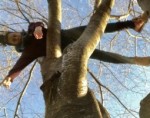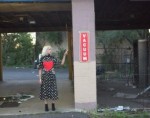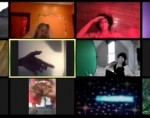
Photo: Knut Bry
Horror and Humor in a Fictional Cold-War Society
By: Nicole Bindler
Three white, European men are onstage as the audience enters. One, played by Trond Fausa Aurvåg, sits nervously cleaning a coffee cup with a rag. Another, played by John Fjelnset Brungot, voraciously chews gum behind a counter full of shelves, each with one white coffee cup nestled inside. The third, played by Bartek Kaminski, sits pensive and waiting opposite Aurvag with his head in his hands.
The space is filled with wood and worn leather, suits and ties, earth tones and nostalgia: an antique radio, a glowing space heater, a rotary phone, a hand coffee grinder.
As the house lights dim, the music begins, emanating not from the speakers, but the performers: mist from a spray bottle, the squeak of a rag against the cup, a sigh, the grumble of the coffee grinder. Music.
Then comes the French gibberish, virtuosic in its crystalline and clown-like delivery. The audience provides a laugh-track to punctuate their nonsensical dialogue. The cadence, rhythm, repetition and attention of the performers is entrancing. I am drawn into their world dripping with pleasure and reverence for coffee. Coffee represents their nation-state, their identity, their blood.
The caricatured Frenchmen entertain with their haughty snobbery, upturned noses and dismissive brushes of the hand, but little differentiates one from another. As Jo Strømgren’s The Society unfolds, issues of cultural stereotyping and the role of choreography within theater simmer to the surface.
Kaminski performs a too-brief, mysterious, cathartic solo in his chair, writhing as if being shocked. A foreshadowing perhaps.
Aurvåg finds a tea bag, a proxy for China, in a drawer. It is met with horror and disgust. Interrogations ensue. The surreal torture that comes --electrocution and holding the hot space heater-- is utterly disproportionate to the presumed threat. Yet we know the pained history of the Cold War to the present day (look no further than Bradley Manning), so we understand that this absurd proposal onstage is all too real.
Phone calls, answered by Aurvåg in English. Infiltration of Chinese objects. Trio dance routines. These events repeatedly intersect.
The dance sections are less embodied than the speaking, appearing as demonstrations or asides, whereas the narrative itself evokes body-states that I’d love to see Strømgren more deeply investigate through movement with his versatile performers.
The three men perform the choreography most often in a tight, static, equilateral triangle. They never expand their physicality beyond their
kinespheres (though they embody and electrify the space around them when they are not “dancing”). The most realized dancing comes after Kaminski is electrocuted and retains a grotesque, residual twitch in his body even as he attempts to resume regular interactions with the other characters. I’m compelled by the strange beauty, humor and vulnerability of his movement and crave more dance arising from the action in the play, rather than a “dance” inserted as a separate event.
As more stereotypically Asian artifacts invade --an image of Mao, chopsticks, fine-haired black wigs, martial arts attire inhabited by some deep lunges and punches-- I become deeply uncomfortable. As a white American who had been taught at an early age not to slant my eyes with my fingers, the performers’ depiction of Asian demeanor through toe walking and a quick nodding of the head seems horribly taboo.
Strømgren says in an interview on the Fringearts blog:
“The only place we have had problems is actually in USA ...Every region has its taboos, and America with its dark history of discrimination is different than the rest of the world. One can say very little about Asians, Blacks, Jews and the mentally retarded in America. In principle it is good, but one should be careful with imposing moral codes when something comes from abroad.”
Europe also has a dark history (and present) of discrimination. I presume this is intrinsic to the humorous and chilling xenophobia The Society’s French characters express prior to the Chinese infiltration. So I am puzzled by Strømgren’s dismissal of a critique of his stereotypical portrayals of Chinese people in this work as simply reflective of the American point of view.
Both the French and Chinese stereotypes smudge the nuance and multiplicity of human experience to a comic-book reduction. The fear that underlies hatred and cultural misunderstanding is sharply depicted in The Society, but unfortunately, not transcended.
The Society, Jo Strømgren Kompani, Painted Bride, Fringearts Festival, Sept 6th-8th.
http://jskompani.no/
By Nicole Bindler
September 10, 2013







.png)


